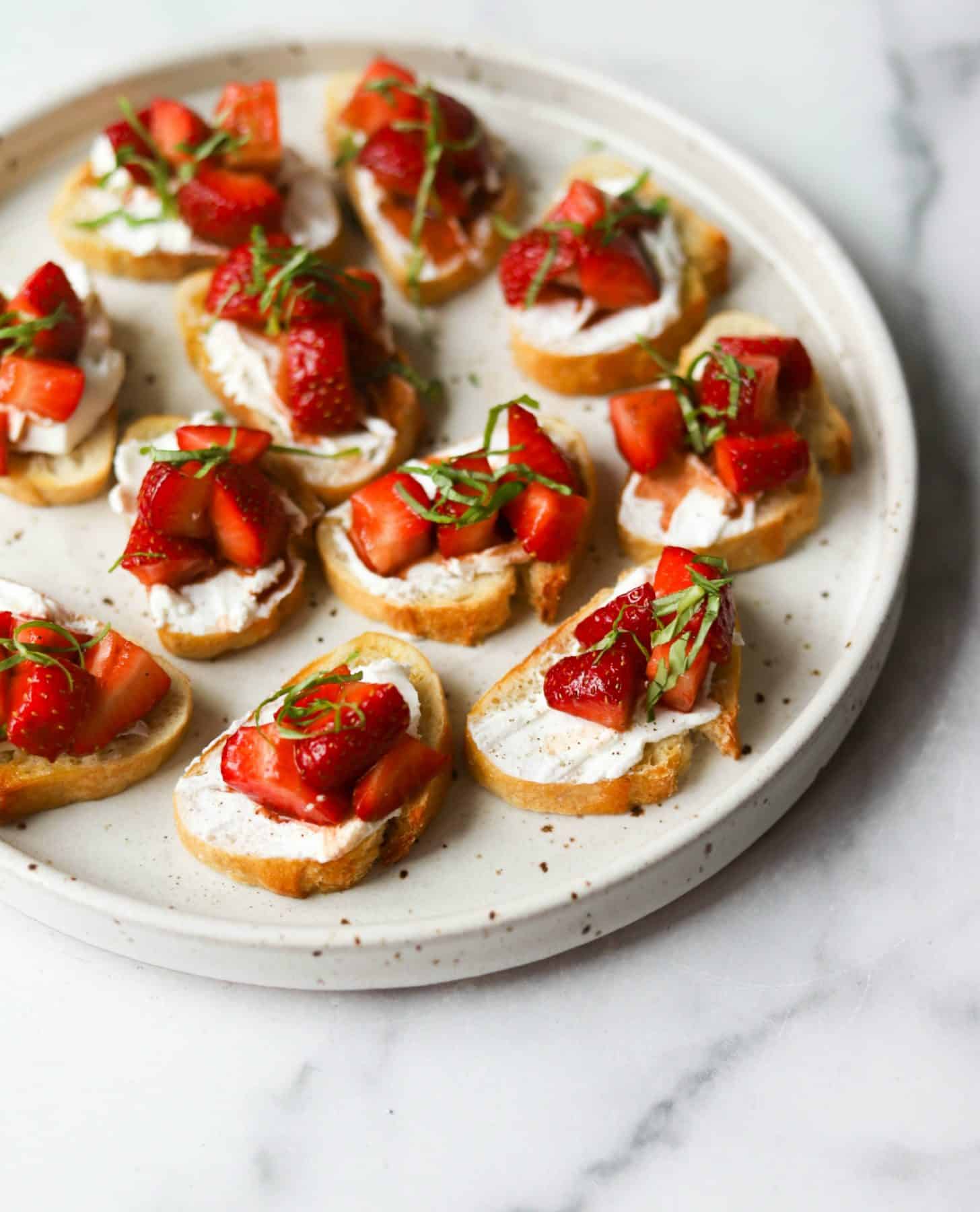90+ Fresh Herb Recipes
Is your garden sprawling with fresh herbs? Are you looking for ways to use up a bunch of fresh herbs that are sitting in your vegetable crisper? Or, are you just craving something super fresh? Well, I’ve got just the recipe round-up for you!
Whether it’s basil, cilantro, parsley, thyme, rosemary or dill, this giant batch of recipes is sure to please. There is everything from appetizers and snacks to soups, salads and main dishes to condiments and desserts. Surely you’ll find something to keep those fresh herbs from going to waste!
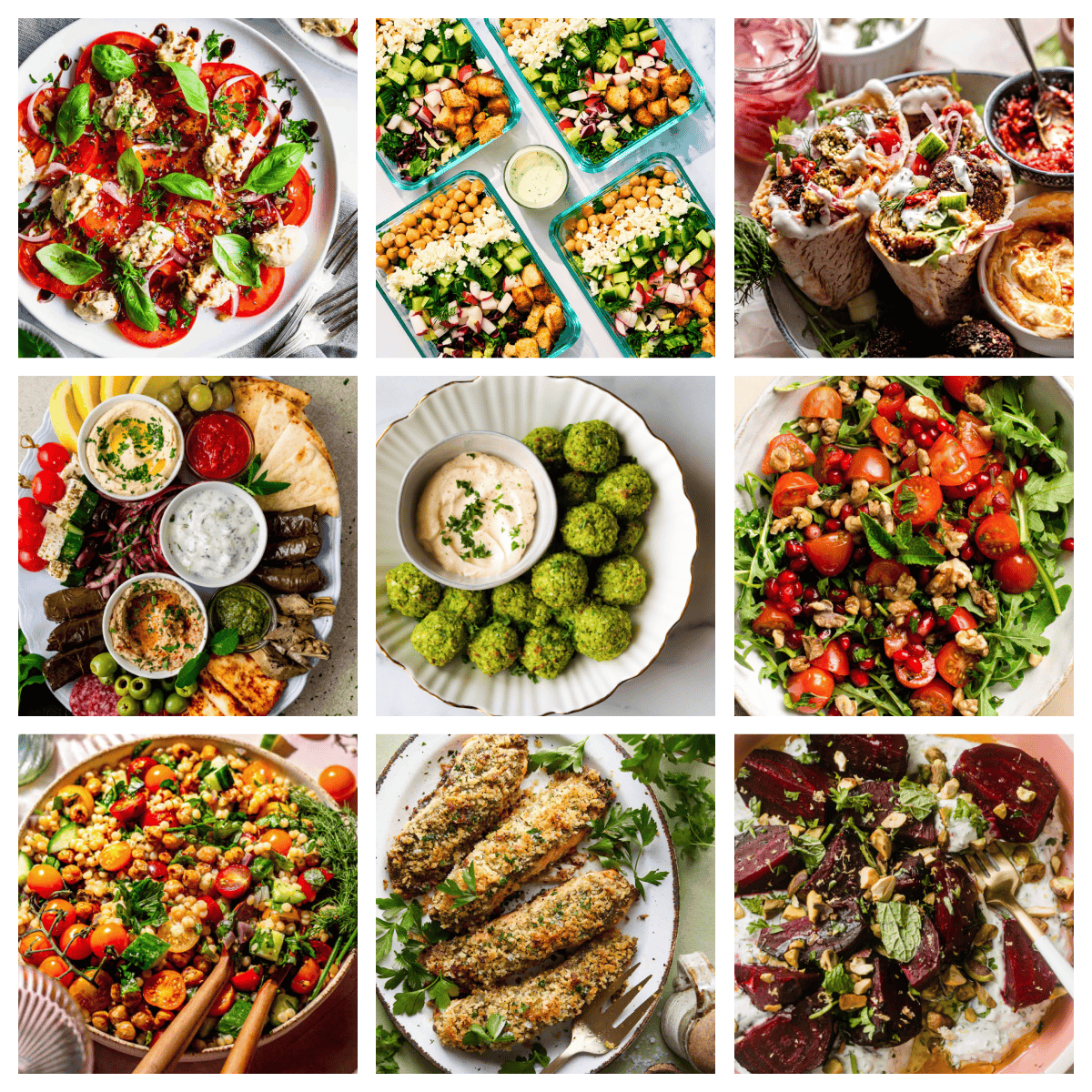
How to use and save fresh herbs
If you don’t regularly cook with fresh herbs, having a bunch stashed in the fridge can be easily overlooked or forgotten. Part of the challenge is that many fresh herbs are sold in large bundles and it can be hard to use them up before they go bad.
But with a few cooking tips and tricks and a handful of yummy recipes, you can conquer food waste and add fresh and flavorful herbal notes to plenty of dishes.
My favorite ways to store herbs:
- Store a bunch of fresh herbs in a jar of water, on the counter.
- Store herbs in the refrigerator in a zip-top plastic bag or sealed container with a paper towel inside to soak up any excess moisture.
- Tie small bunches of herbs with kitchen twine and hang upside down.
- Store herbs in the freezer by chopping them up, placing them in an ice cube tray and filling each well with water or olive oil.
- Freeze, then pop them into a zip-top plastic bag to store frozen.
- Use the water-filled ones for smoothies and drinks and use the olive oil-filled ones for cooking!
Read on for seven simple tips to use up leftover herbs and over 90 recipes you’ll absolutely love.
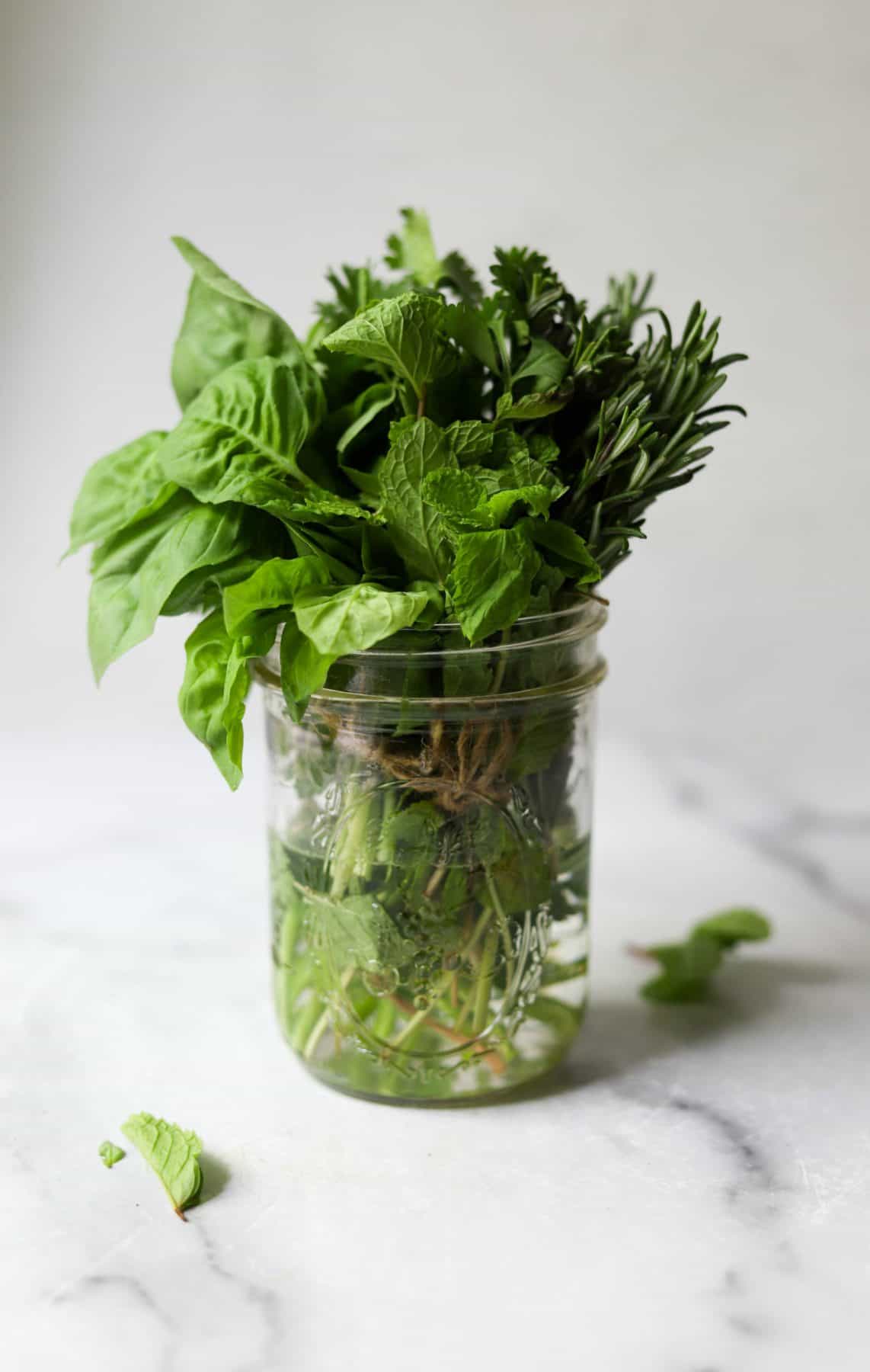
Tip #1: Plan ahead
- The easiest way to use up fresh herbs is to plan out several recipes that use the same herbs at once.
- Making meals that utilize similar ingredients is a surefire way to cut back on food waste. Plus, it equals fewer trips to the grocery store for you!
- If you know you’re making a recipe that calls for a certain herb, plan in advance so you know what other recipes you can make to use it up.
- Let’s say you need a bunch of fresh basil for a pesto pasta recipe, like this Caprese Pesto Pasta Salad.
- You can use up any remaining basil by making extra pesto for roasted vegetables, like these Pesto Roasted Baby Potatoes.
- Or toss basil leaves in a fruit smoothie or on a sandwich, like this Grilled Cheese with Bacon, Cherries, and Basil for an unexpected herbal twist.
Tip #2: Garnish your meals with herbs
- If you think garnish is just for fancy restaurant meals, think again.
- Finishing a home cooked meal with a sprinkle of fresh herbs adds a light, fresh flavor note.
- Plus, it looks seriously pretty.
- Impress your family and friends with an extra pop of green herbs on any recipe.
- You can try adding fresh herbs to garnish soups, pasta, casseroles, egg dishes, dips and appetizers like this recipe for Strawberry Basil Bruschetta!
- A tip for prepping your garnish: finely chop whatever herb you’re using so you don’t end up with uneven or extra large pieces.
- Chop just before garnishing since some herbs, like basil, parsley, and cilantro are tender and can bruise and wilt quickly after being chopped.
- Also, be sure to add your garnish away from a heat source to prevent wilting.
Tip #3: Infuse your drinking water
- If you have just a few sprigs of an herb, a quick and easy way to use it is to add it to your drinking water for a boost of flavor.
- Try experimenting with herb, fruit, or vegetable combinations for different flavored waters.
- Pair mint with lemon or basil with strawberries to make meeting your hydration needs a little more fun and flavorful.
Tip #4: Make homemade sauces, dips and dressings
- Herb based sauces, like pesto and chimichurri, have a multitude of culinary uses.
- Traditionally, pesto is made from finely chopped basil blended with olive oil and garlic.
- But you can make pesto from any tender herb including parsley or cilantro.
- Use pesto on salads, grain bowls, pasta, as a sandwich spread, or as a pizza topping, like my Mediterranean Flatbread Pizza.
- Chimichurri is traditionally made from chopped parsley and cilantro blended with olive oil and garlic.
- But again, play with the herbs you have on hand. Use chimichurri sauce for topping steak, poultry, and seafood.
- You can also use finely chopped leftover herbs to make homemade salad dressings and healthy dips.
Tip #5: Add herbs to salads
- Fresh herbs can transform a basic green salad.
- Try tossing whole leaves of mint, basil, parsley, cilantro, or dill to your favorite greens to create an herbal salad like this Spring Veggie & Burrata Salad.
- You’ll get an extra dose of flavor and super nutritious greens!
- You can also add large bunches of herbs to a grain salad, like in this recipe for Breakfast Tabbouleh.
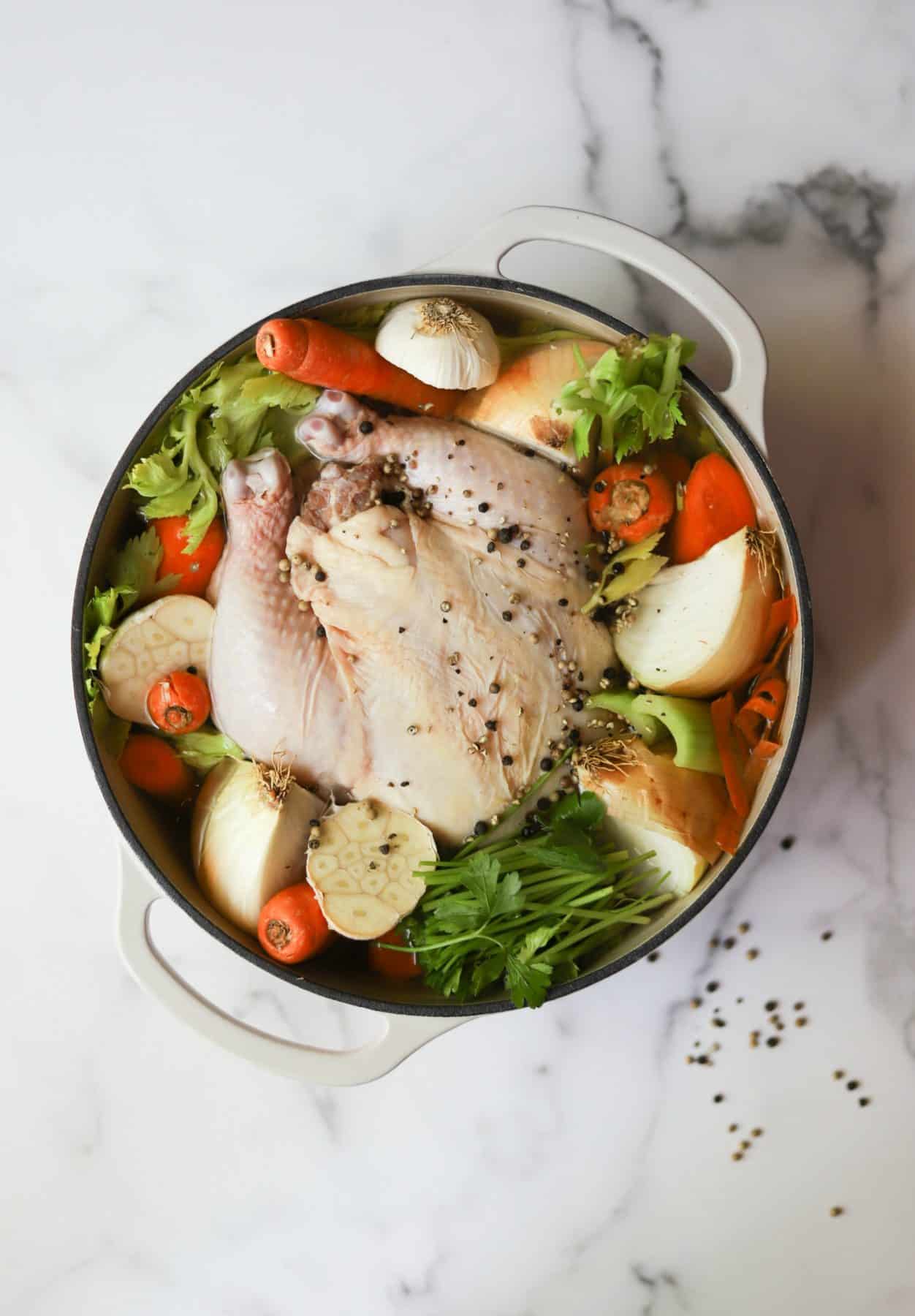
Tip #6: Make homemade stock
- Making your own stock is one of the best ways to use up bunches of leftover herbs like parsley and thyme, along with vegetables approaching the end of their shelf-life.
- Stock is incredibly simple to make, it’s a one pot recipe and I promise you can’t beat the flavor of homemade stock!
- Make a batch of Homemade Chicken Stock and then use to make soup or freeze for later use.
Tip #7: Make your own dried herbs
- Finally, if you know you’re not going to get around to cooking with your leftover herbs, try drying them to extend their usable life.
- Tie small bunches of herbs with kitchen twine and hand upside down.
- Warmth and humidity can inhibit the drying process, so the kitchen probably isn’t the best place to do this.
- Drying can take anywhere from a few days to about a week.
- You’ll know the herbs are dried when they crumble easily.
- Simply crumble them up and store in airtight containers.
- Keep these tips handy for the next time you find yourself buying a bunch of fresh herbs.
- Committing to cooking with fresh herbs means more flavorful and colorful food and more bang for your grocery buck.
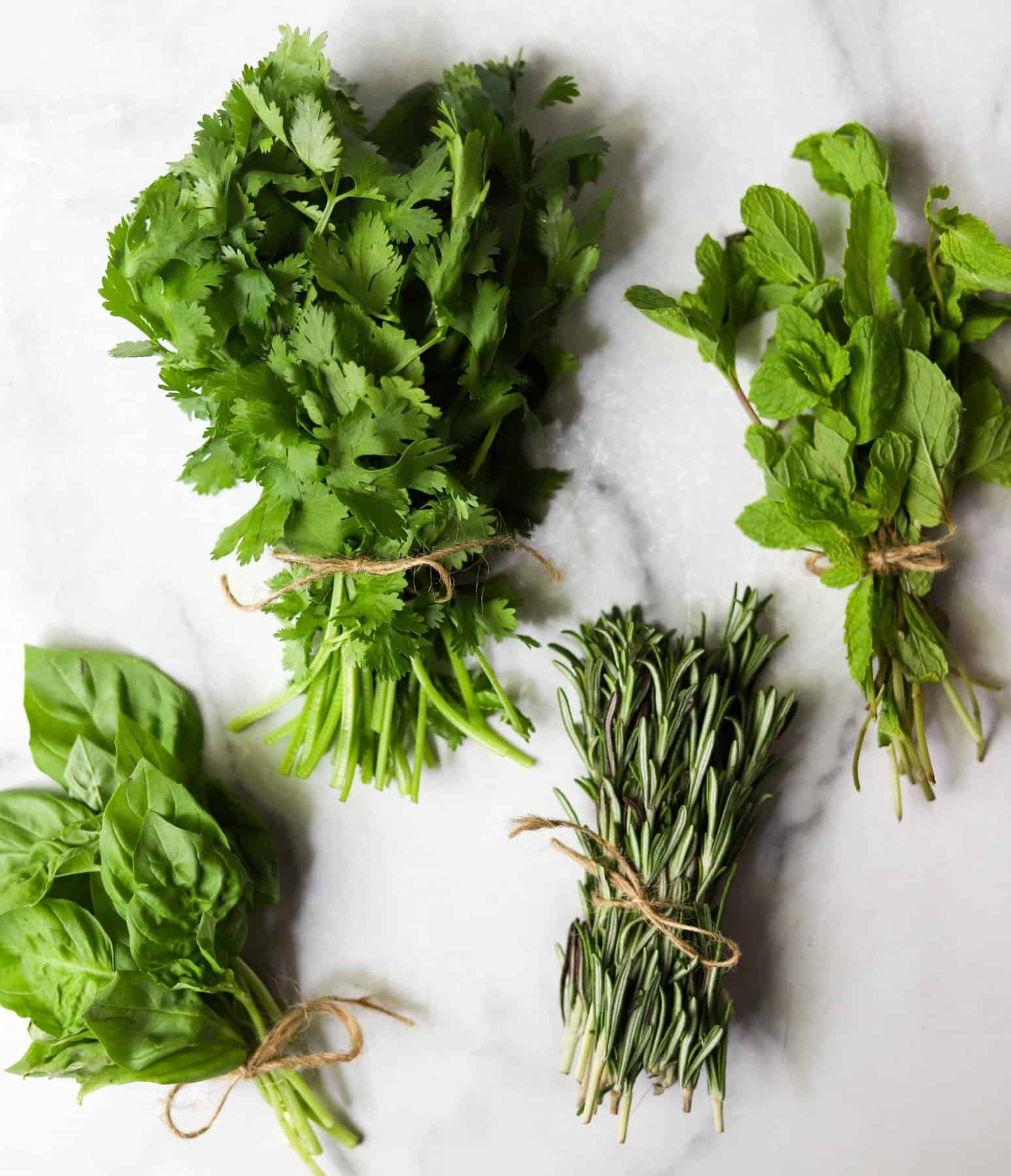
90+ Fresh Herb Recipes to Try
Appetizer Recipes with Fresh Herbs
Strawberry Basil Bruschetta
These strawberry basil bruschetta are made with mini toasts, goat cheese, juicy strawberries in balsamic and fresh basil.
The perfect easy summer appetizer that will look beautiful on the plate but will only be there for a split second, long enough for you and your guests to gobble them all down in a matter of minutes.
Mediterranean Charcuterie Board
15 minutes is all you need to make an impressive Mediterranean charcuterie board! The perfect addition for fun get togethers that is full of all your favorite mezze including stuffed grape leaves, an assortment of dips, briny olives and fried halloumi cheese.
There’s a delightful pairing for everyone to mix, match and enjoy!
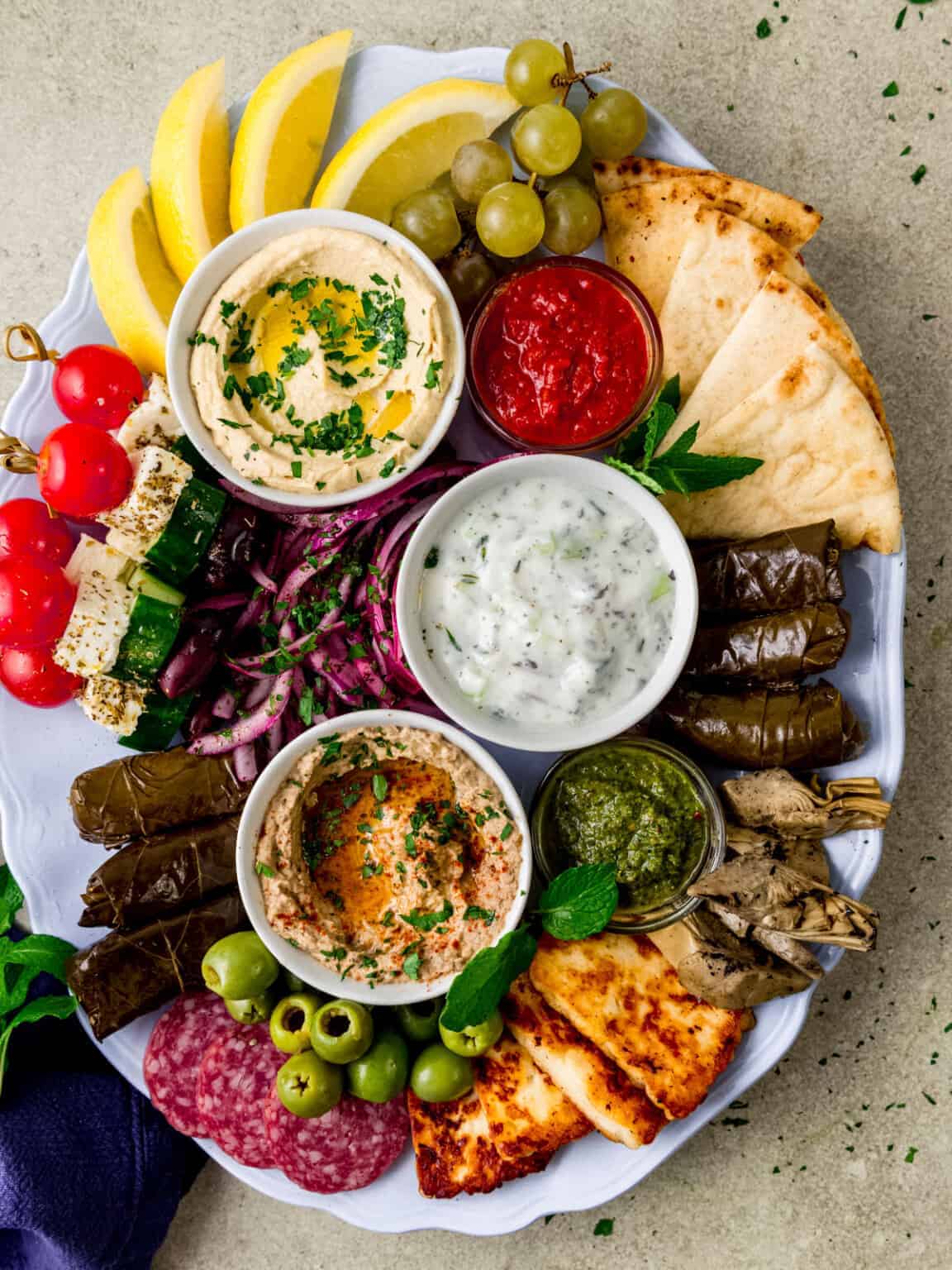
Edamame Falafel with Spicy Lemon Aioli
Have you ever made falafel at home? It’s so easy to whip up the batter in your food processor, roll ’em up and bake ’em!
This recipe is a fun take on traditional chickpea falafel. It’s made with frozen edamame, lemon, garlic and fresh herbs. All served with a spicy lemon dipping sauce.
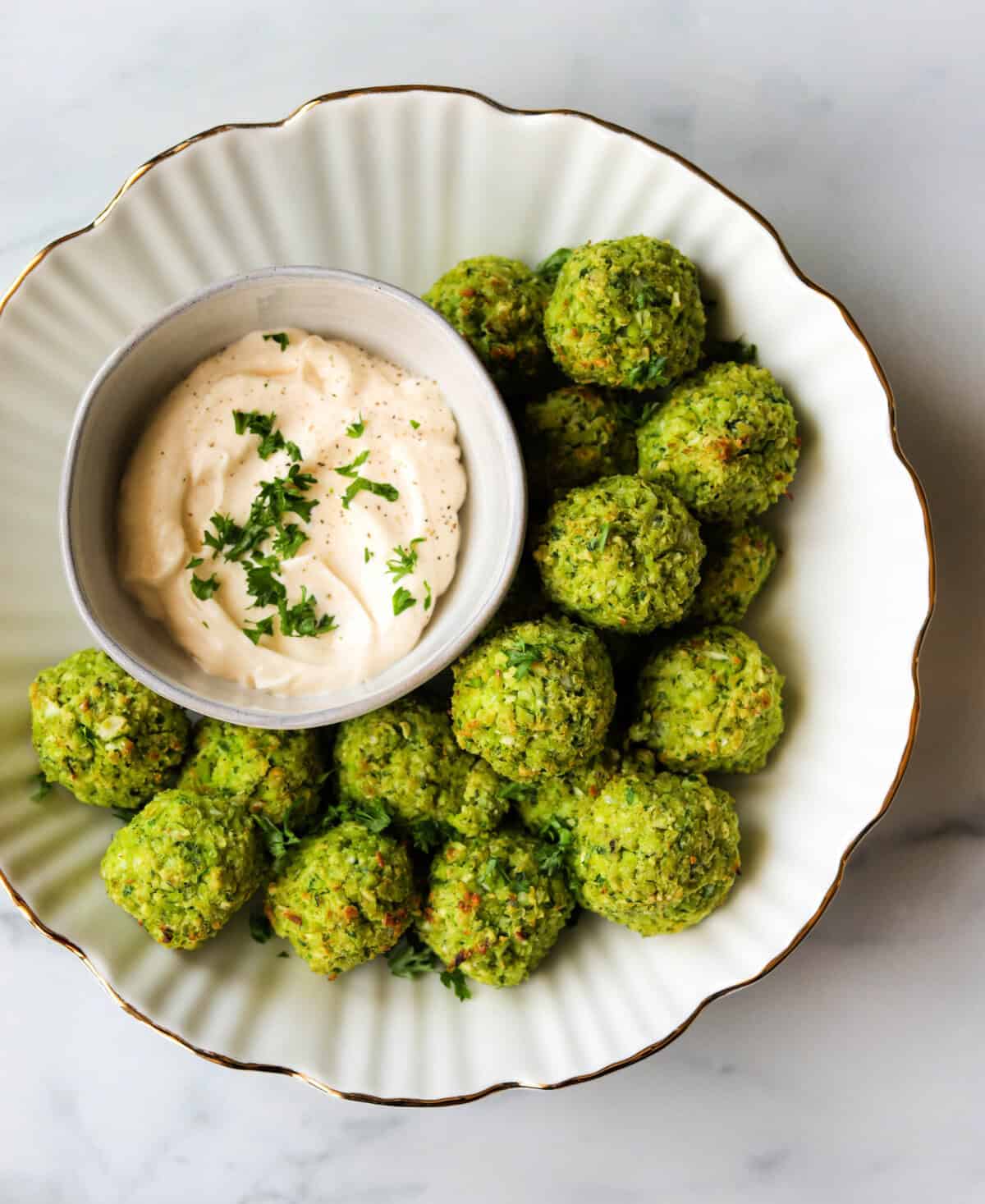
Try these other appetizer recipes with fresh herbs
- Fried Pickle Dip
- Cod Ceviche with Watermelon, Avocado and Mint
- Basil Lime Hummus
- Za’atar Focaccia
- Marinated Mozzarella Balls
- Garlic Herb Cheese Log
- Herb and Garlic Marinated Olives
Breakfast Recipes with Fresh Herbs
Mediterranean Tabouli with Poached Eggs
A breakfast (or brunch) version of classic Mediterranean tabouli with poached eggs and pita wedges for a delicious, satisfying and easy meal!
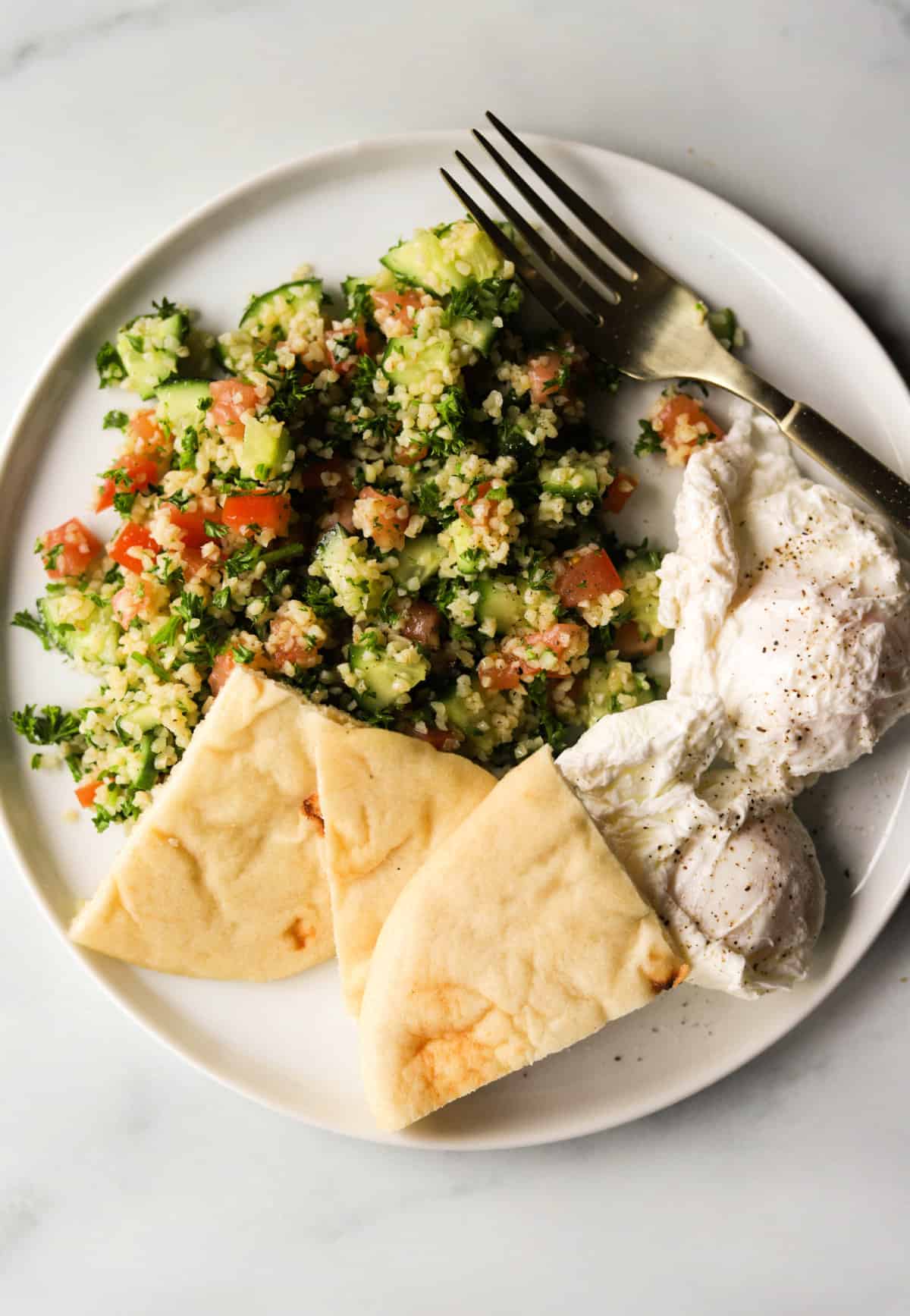
Try these other breakfast recipes with fresh herbs
- Za’atar Eggs with Yogurt Chili Butter
- Savory Monterey Jack and Green Onion Pancakes
- Herby Breakfast Skillet
- Feta and Herb Scrambled Eggs
- Shakshuka
Soup and Salad Recipes with Fresh Herbs
Dill Pickle Salad
This chopped dill pickle salad is creamy, crunchy, and packed with 30g of protein per serving! Made with buttery croutons, crisp veggies, feta, and a oil-free dill pickle dressing (made with Greek yogurt).
Delicious, high-protein, and meal prep friendly with a gluten-free option.
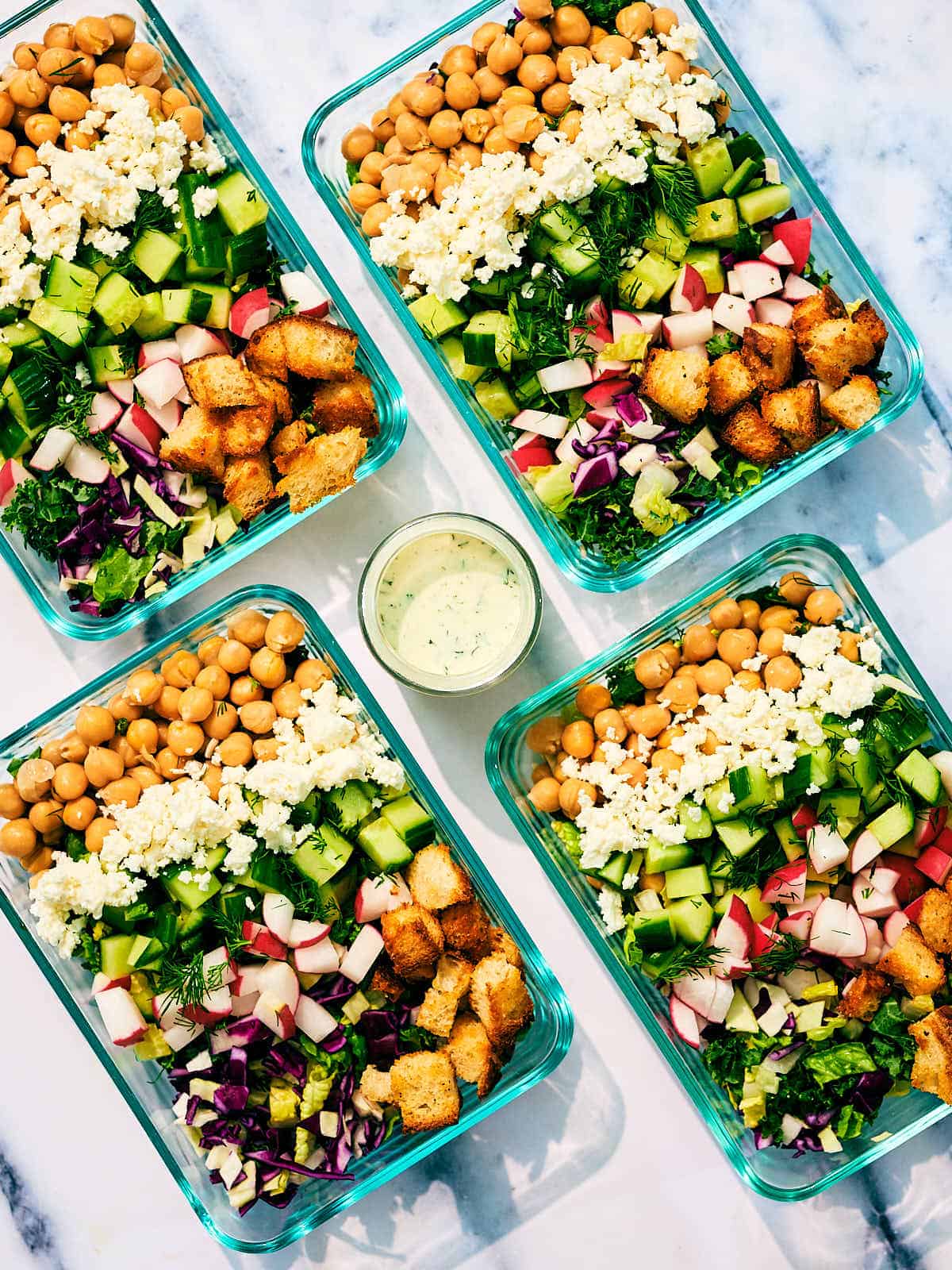
Rocca Salad with Arugula
Rocca salad made using simple ingredients like arugula, cherry tomatoes, pomegranates, herbs and walnuts!
So fresh, crunchy, tangy and tasty! Topped off with a healthy dressing.
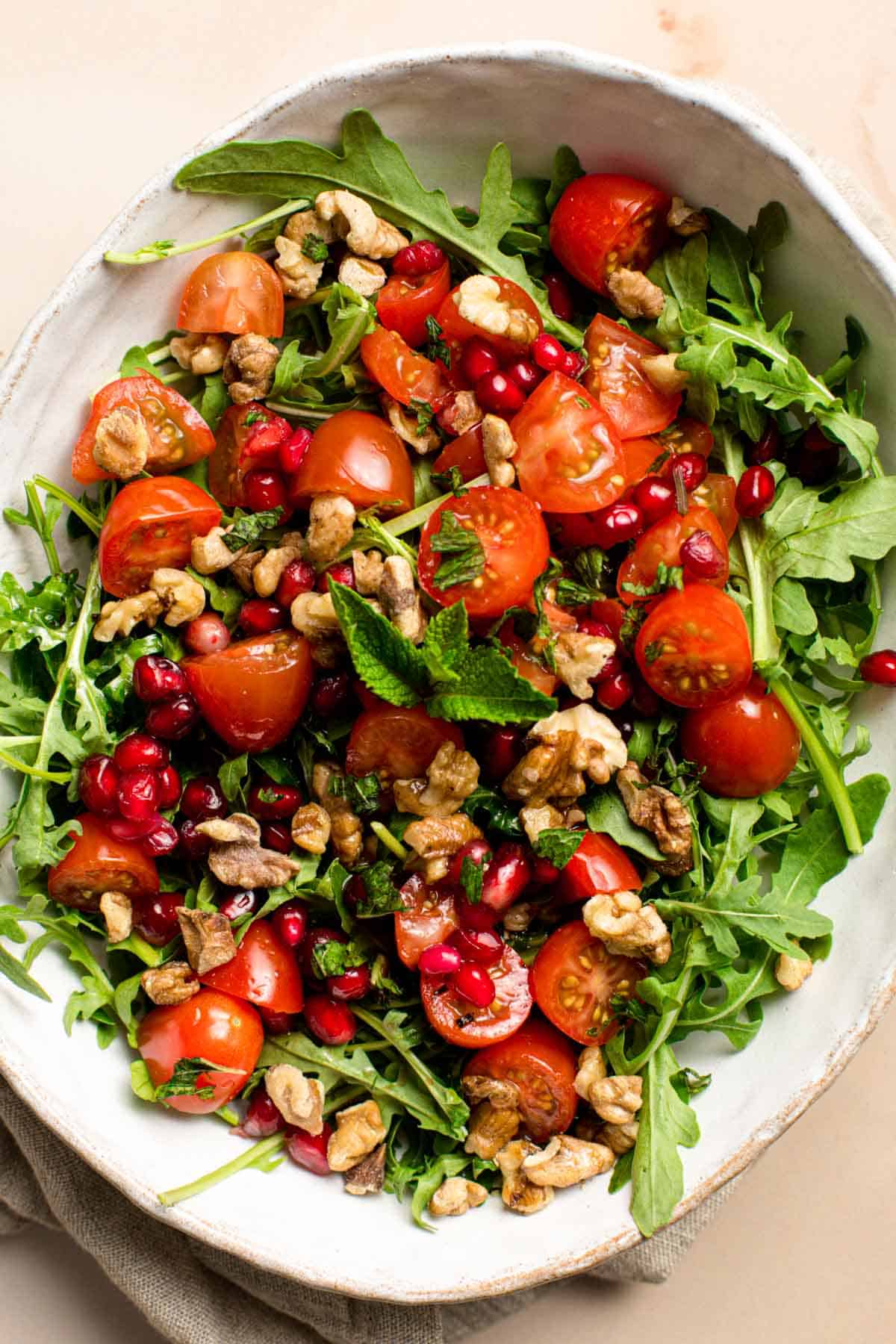
Tomato Carpaccio Salad
Easy, no-cook tomato carpaccio done in 10 minutes, guaranteed to impress your guests effortlessly!
It’s quick, looks and tastes delicious, and is so easy to make!
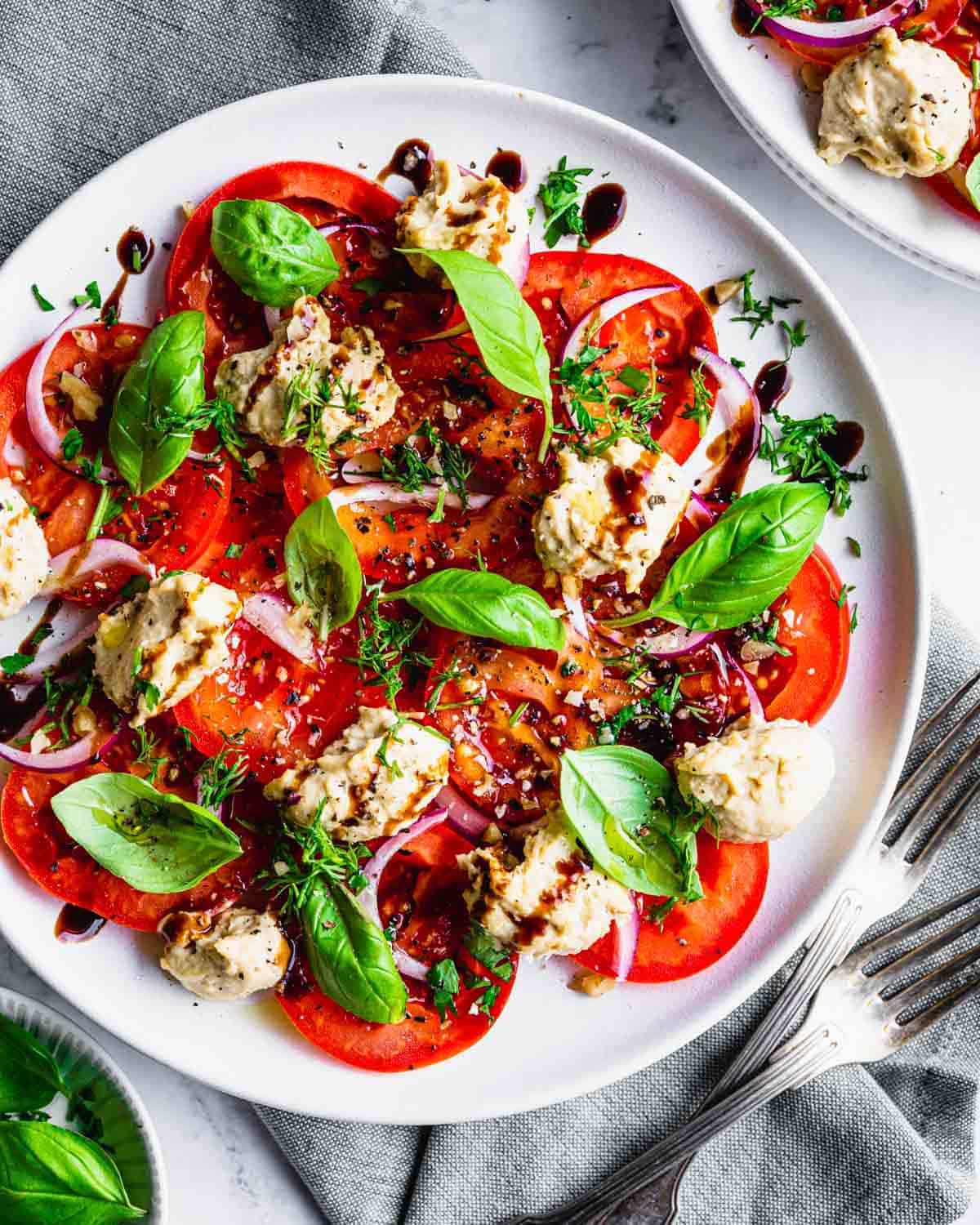
Lemon Herb Couscous Salad
This vibrant vegan lemon herb pearl couscous salad features a fresh mix of crisp vegetables tossed in a zesty, homemade lemon vinaigrette.
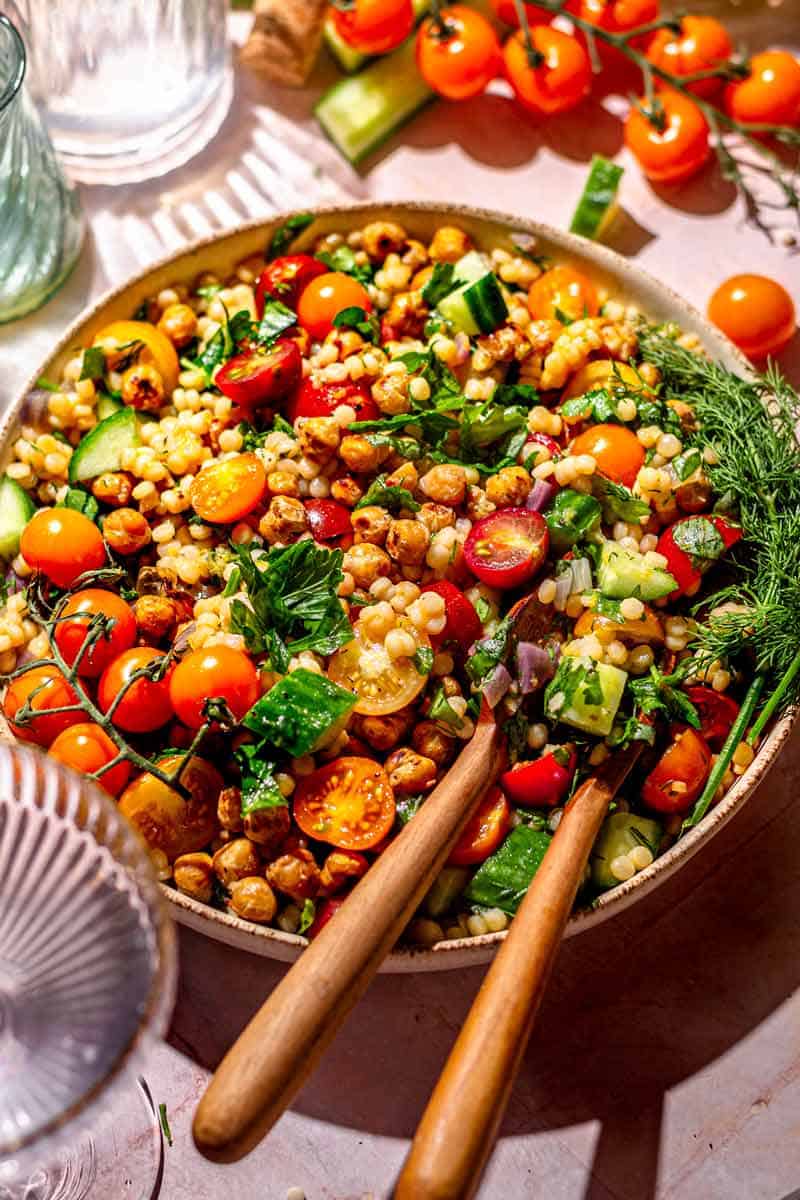
Middle Eastern Bean Salad
Balela Salad is a classic middle eastern bean salad that’s loaded with interesting flavors and healthy ingredients.
This makes a great lunch or side-dish salad any time of year, but when you have fresh garden tomatoes it will be even better!
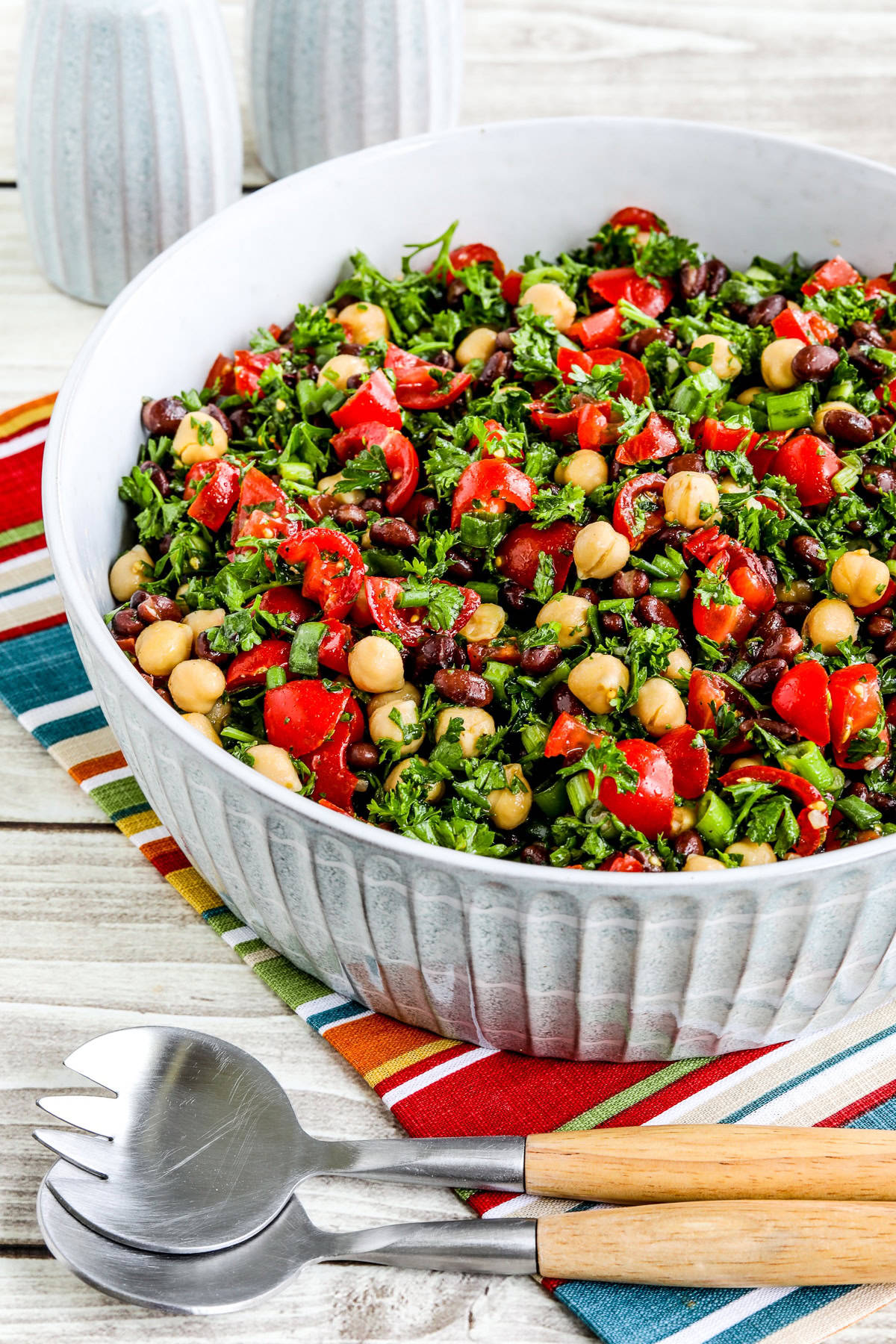
Pesto Tomato Soup
This creamy pesto tomato soup is made with San Marzano tomatoes, dollops of basil pesto, cream and Italian herbs.
It’s easy and quick to make and is restaurant quality!
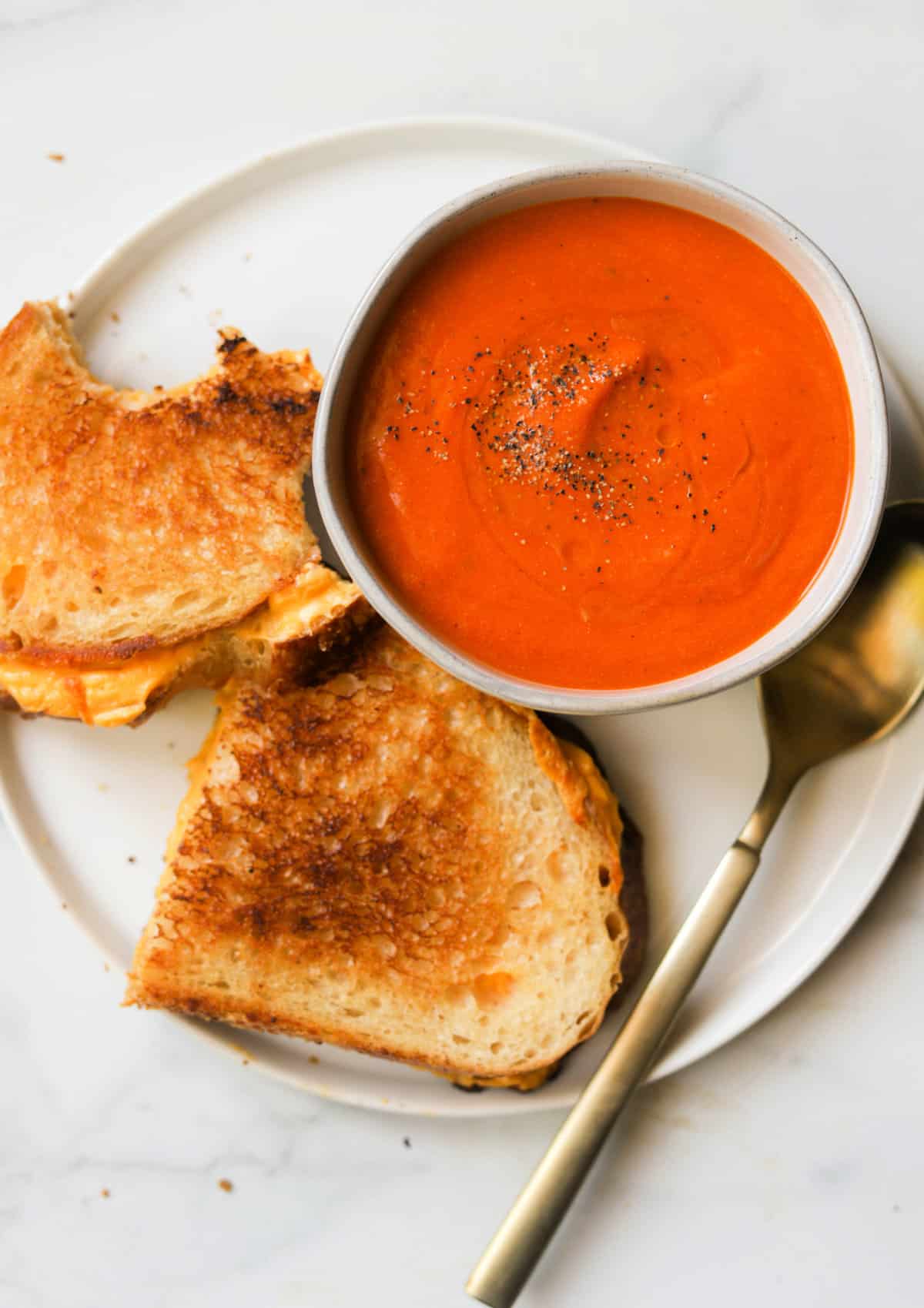
Asparagus Potato Soup
This simple, tasty plant-based soup is packed with fresh asparagus, Yukon gold potatoes, fresh and dried herbs and aromatics.
It’s pureed with sherry vinegar and fresh lemon juice for a perfect finish.
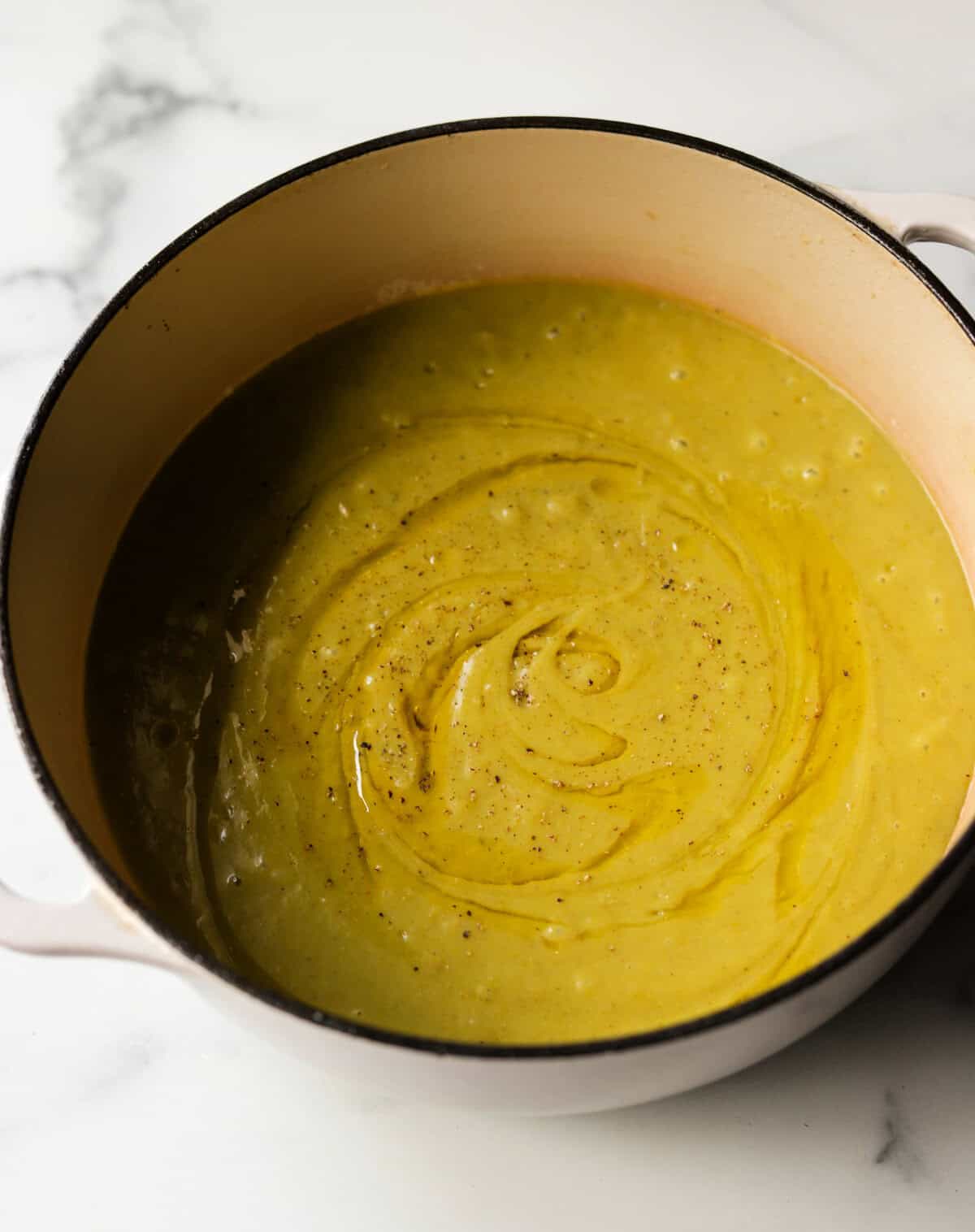
Try these other soup and salad recipes with fresh herbs
- Creamy German Cucumber Salad
- Greek Lettuce Salad with Feta Cheese
- Thai Beef Salad
- Peach and Goat Cheese Salad
- Cucumber Beet Salad
- Green Goddess Chicken Salad
- Chickpea Cucumber Salad
- Mint Pea Salad
- Fresh Oregano Salad
- Pesto Potato Salad
- Mediterranean Cucumber Salad
- Zesty Cucumber Salad
- Brown Rice and Quinoa Salad
- Chinese Chicken Salad
- Israeli Couscous Salad
- Cilantro Salad
- Peach Watermelon Salad
Main Dish Recipes with Fresh Herbs
Air-Fryer New York Strip with Garlic Herb Butter
Do you like steaks?
Well, if your answer is yes, then you are in for a treat! In today’s blog post, am excited to show you how I make the most flavorful steak in the air fryer.

Parsley Walnut Pesto Rigatoni
This flavourful vegan parsley walnut pesto is simple to make and full of fresh greens and walnuts.
This recipe also includes a 4 serving pasta measurement to make a quick and nutritious weekday dinner.

Mediterranean Pizza
This Mediterranean Pizza is perfect as a healthy weeknight dinner! Made with spinach, black olives, artichokes, red onion, and crumbled feta, this quick pizza recipe is full of flavor.
Vegetarian, delicious, and so easy to make!

Pesto Crusted Salmon
This yummy salmon includes herby pesto with a zesty panko crust. It’s the perfect main dish during the week.
It’s filling, flavorful and works well with salad, bread, and potato sides. Plus, it’s ready in less than half an hour!

Falafel Pita Sandwiches
This homemade crispy falafel pita sandwich has lots of fresh herbs, golden brown falafel balls, and creamy hummus packed inside fluffy soft pita bread.
Served hot or cold, this recipe makes a delicious vegan lunch or an easy weeknight dinner.

Try these other main dish recipes with fresh herbs
- Persian Herb Stew
- Tuna Pesto Pasta
- Broccoli Pesto Pasta
- Thai Basil Chicken with Peppers
- Air Fryer Marinated Lamb Chops
- Potato and Rosemary Pizza
- Herb Butter Salmon
- Pesto Gnocchi
- Herbs de Provence Roasted Chicken and Potatoes
- Cilantro Lime Shrimp
- Pan-Fried Chickpeas with Fresh Herbs
- Turkish Spinach Pie
- Pasta Fresca
- Marinated Chicken Skewers with Fresh Herbs
- Shawarma-Spiced Grilled Chicken
- Mussels in Cream Sauce
- Mediterranean-Stuffed Balsamic Pork Loin
Side Dish Recipes with Fresh Herbs
Pesto-Roasted Baby Potatoes
If you’re looking for an easy and yummy side dish, look no further than these roasted pesto potatoes.
They come together in no-time and go with pretty much any main dish.
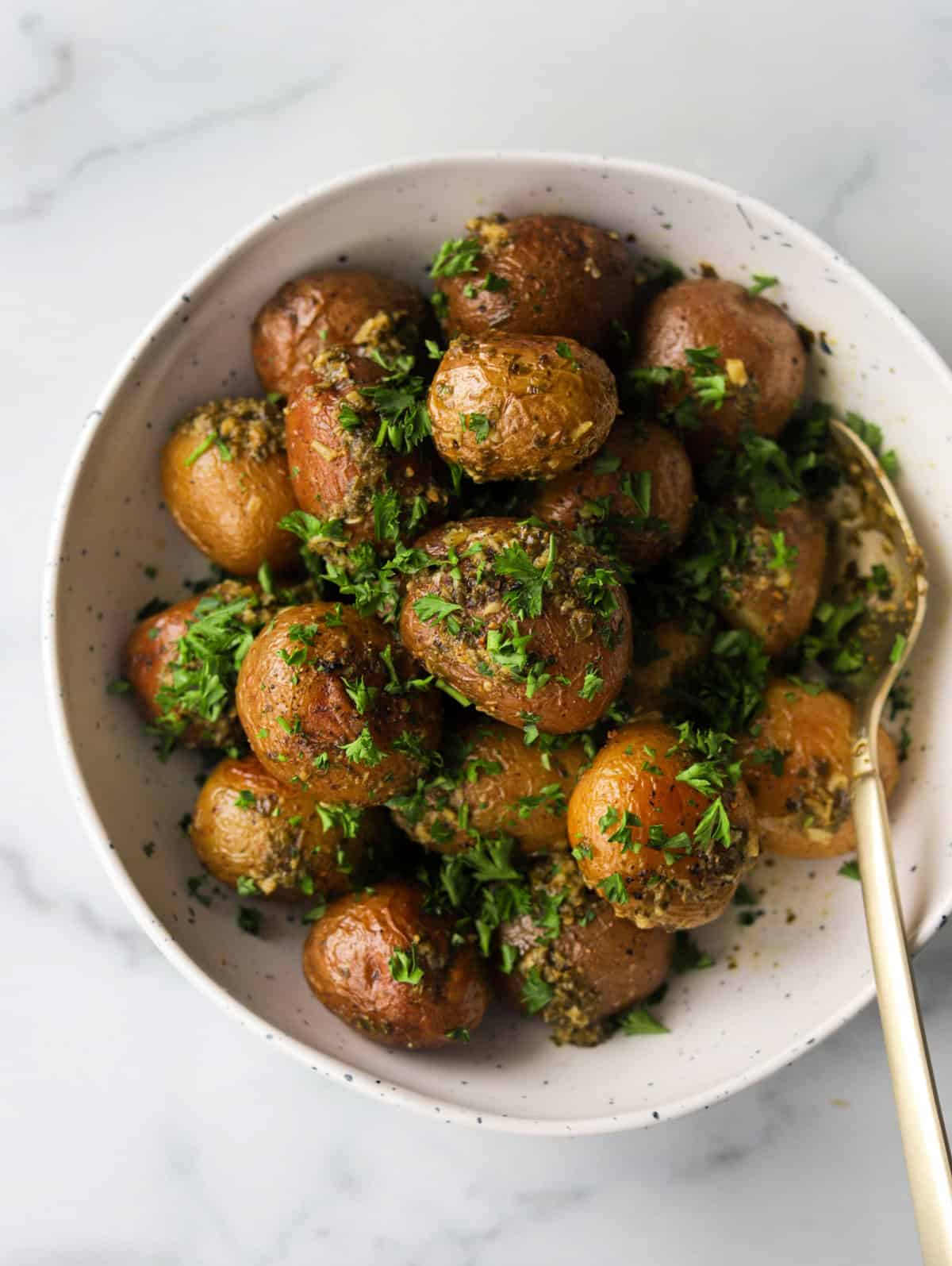
Cast Iron Focaccia with Rosemary
This homemade focaccia has a thick crispy bottom with a super light and airy interior and a thin crispy golden top.
It’s topped with fresh rosemary, flaky sea salt, and a drizzle of extra virgin olive oil for an herby, salty, and savory bit in each bite.

French Green Beans with Herb Butter
These French-style green beans in garlicky herb butter make for a delicious fresh side dish!
They are quick, easy, healthy and so flavorful – seasoned simply with fresh herbs and lemon juice.

Roasted Beets with Herby Skyr and Pistachios
Earthy roasted red beets with herb-flecked yogurt and toasted pistachios make a wonderful weeknight dinner side dish.

Lentil Tabbouleh
A higher protein salad, this lentil tabbouleh is made with plenty of fresh parsley, mint, and bright summer vegetables for a filling salad.

Try these other side dish recipes with fresh herbs
- Garlic Herb Slow Cooker Roasted Potatoes
- Tortillini with Avocado Pesto
- Stuffed Garlic Bread
- Vietnamese-Style Rice Salad
- Chimichurri French Fries
- Lemon Herb Quinoa
- Crispy Sweet Potatoes with Parsley Salsa Verde
- Thai Basil Eggplant
Condiment and Sauce Recipes with Fresh Herbs
Sun-Dried Tomato Pesto
This pesto rosso (also known as sun-dried tomato pesto) is the most delicious sauce! It’s so good in pasta, on pizza or as a spread for a piece of crusty bread.
This versatile sauce is made with a handful of simple ingredients in about 15 minutes.

Parsley Pesto
Use a bunch of parsley, stems and all, to make this parsley pesto!
A milder variation, this can be made with several different nuts or seeds.

Salsa Fresca
Homemade Pico de Gallo or Salsa Fresca made with fresh tomatoes, aromatics and herbs!
This chunky salsa recipe is perfect for scooping with tortilla chips or as a topping for tacos.

Try these other condiment and sauce recipes with fresh herbs
- Chimichurri Sauce
- Chermoula
- Basil Pesto
- Wild Weeds Pesto
- Herb Compound Butter
- Basil Simple Syrup
- Spicy Peruvian Green Sauce
- Herb Salt
- Pistachio Pesto
- Smoked Chive Butter
- Cilantro Lime Vinaigrette
- Chive Oil
- Green Pasta Sauce
- Mango Cilantro Salsa
Dessert Recipes with Fresh Herbs
Ekmek Kataifi
Ekmek Kataifi is a luscious, Greek dessert with shredded phyllo dough drenched in syrup that’s topped with custard and then whipped cream!
Add fresh basil or mint as a garnish for a fresh finish!



